Themed collection Precious Elements

Configuring solid-state batteries to power electric vehicles: a deliberation on technology, chemistry and energy
Solid-state batteries are configured by deliberation of technology and energy, with material chemistries and processing parameters necessary to target the requirements of the roadmap of future energy-dense and safe batteries.
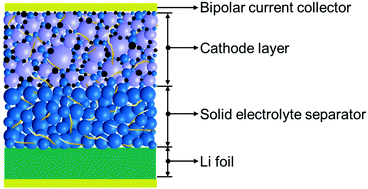
Chem. Commun., 2021,57, 12587-12594
https://doi.org/10.1039/D1CC04368D
Designing flexible, smart and self-sustainable supercapacitors for portable/wearable electronics: from conductive polymers
Progress of utilizing conductive polymers and their composites to prepare flexible, smart and self-sustainable supercapacitors for portable/wearable electronics is reviewed.
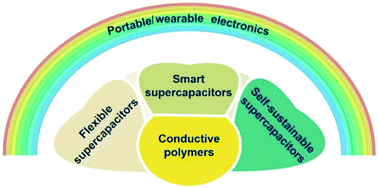
Chem. Soc. Rev., 2021,50, 12702-12743
https://doi.org/10.1039/D1CS00800E
Redox flow batteries: a new frontier on energy storage
A deep review of the state-of-the-art of Redox Flow Batteries (RFBs), a technology that aims to become the leading stationary energy storage, covering individual components, economic analysis and characterization techniques.

Sustainable Energy Fuels, 2021,5, 5366-5419
https://doi.org/10.1039/D1SE00839K
Technologies of lithium recycling from waste lithium ion batteries: a review
Although the interest in lithium recycling is increasing the current global lithium recycling rate is lower than 1%. For this reason, our paper aims to explain the needs, current state and future directions of lithium recycling technologies.
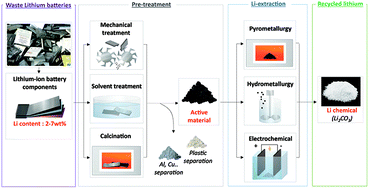
Mater. Adv., 2021,2, 3234-3250
https://doi.org/10.1039/D1MA00216C
Electrochemical methods for materials recycling
The present review describes electrochemical methods for the recovery of chemical feedstocks from waste materials.
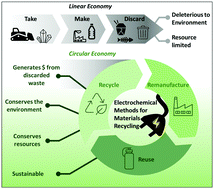
Mater. Adv., 2021,2, 1113-1138
https://doi.org/10.1039/D0MA00689K
Electronic and protonic transport in bio-sourced materials: a new perspective on semiconductivity
Semiconductors of interest in Bioelectronics and Sustainable (Green) Organic Electronics that can feature exclusive protonic or electronic transport, beside mixed protonic-electronic.
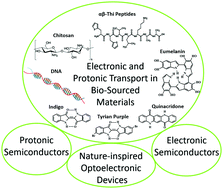
Mater. Adv., 2021,2, 15-31
https://doi.org/10.1039/D0MA00579G
Recent progress in silver nanowire networks for flexible organic electronics
Silver nanowires for flexible organic electronics have been comprehensively summarized from synthesis, film fabrication, characterization and applications to perspectives.

J. Mater. Chem. C, 2020,8, 4636-4674
https://doi.org/10.1039/C9TC06865A
A review of the applications of ion floatation: wastewater treatment, mineral beneficiation and hydrometallurgy
The applications, progress and outlook of ion flotation are discussed.
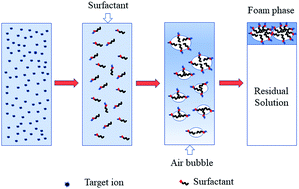
RSC Adv., 2019,9, 20226-20239
https://doi.org/10.1039/C9RA02905B
Organic transistors on paper: a brief review
Organic transistors for flexible electronics applications are usually fabricated on polymeric substrates, but considering the negative impact of plastic waste on the global environment and taking into account the desirable properties of paper, there are more and more efforts to use paper as a substrate for organic transistors.

J. Mater. Chem. C, 2019,7, 5522-5533
https://doi.org/10.1039/C9TC00793H
Advances and challenges of green materials for electronics and energy storage applications: from design to end-of-life recovery
Harnessing biomass to fabricate electronic devices has lately drawn significant research attention because it not only represents a promising strategy for making materials but is also beneficial for the sustainable development of technologies.
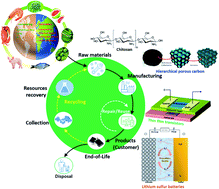
J. Mater. Chem. A, 2018,6, 20546-20563
https://doi.org/10.1039/C8TA07246A
The importance of design in lithium ion battery recycling – a critical review
Product design is an important factor which can control the efficiency and economics of a recycling flowsheet.
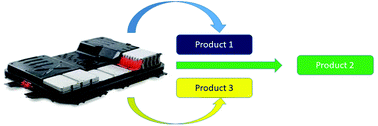
Green Chem., 2020,22, 7585-7603
https://doi.org/10.1039/D0GC02745F
Advancements in the treatment and processing of electronic waste with sustainability: a review of metal extraction and recovery technologies
This review highlights the current status of e-waste recycling and provides insights on metal recovery from e-waste via green chemistry.
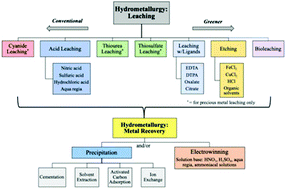
Green Chem., 2019,21, 919-936
https://doi.org/10.1039/C8GC03688H
Reconfigurable 3D-printable magnets with improved maximum energy product
This work establishes a new way to prepare reconfigurable printable magnets based on Wax/CoFe2O4 nanoparticles for advanced applications.
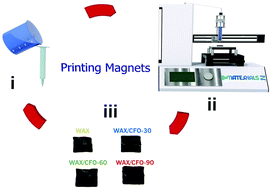
J. Mater. Chem. C, 2020,8, 952-958
https://doi.org/10.1039/C9TC06072C
Electric potential-determined redox intermediates for effective recycling of spent lithium-ion batteries
Based on an electric potential test, Fe3+ was selected as an intermediate for synergistic salt leaching of valuable metals from spent LFP and NCM cathodes, while keeping PO43− separated in the residue as FePO4.
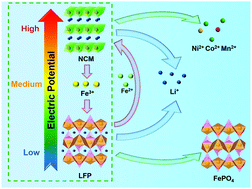
Green Chem., 2022,24, 3723-3735
https://doi.org/10.1039/D2GC00331G
Catalytic dissolution of metals from printed circuit boards using a calcium chloride–based deep eutectic solvent
Catalytic dissolution of metals from printed circuit boards using a calcium chloride–based deep eutectic solvent.
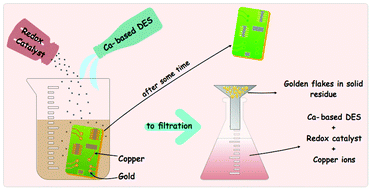
Green Chem., 2022,24, 3023-3034
https://doi.org/10.1039/D1GC04694B
Fluorine-free ionic liquid electrolytes for sustainable neodymium recovery using an electrochemical approach
The application of a fluorine-free ionic liquid electrolyte has enabled cleaner and sustainable Nd recovery via electrodeposition.

Green Chem., 2021,23, 3410-3419
https://doi.org/10.1039/D1GC00361E
Iron-based energy storage materials from carbon dioxide and scrap metal
Ferrous oxalate from carbon dioxide and scrap mild steel stores more energy and carbon than irons oxides prepared from oxalates.
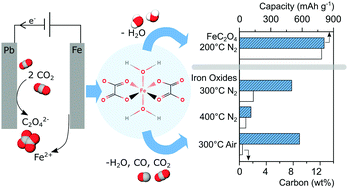
Mater. Adv., 2021,2, 292-302
https://doi.org/10.1039/D0MA00588F
Two-zone ligand-assisted displacement chromatography for producing high-purity praseodymium, neodymium, and dysprosium with high yield and high productivity from crude mixtures derived from waste magnets
Advanced rare-earth separation technology with 100 times higher efficiency than liquid–liquid extraction methods can lead to a circular REE economy.
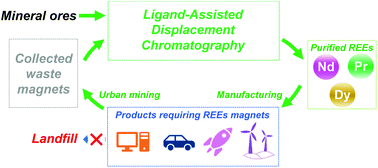
Green Chem., 2020,22, 3769-3783
https://doi.org/10.1039/D0GC00495B
Recovery of niobium and tantalum by solvent extraction from Sn–Ta–Nb mining tailings
The slag from the extraction processes of metals from their ores may contain valuable components that, if adequately recovered, can be reintroduced in the technological life cycle.

RSC Adv., 2020,10, 21406-21412
https://doi.org/10.1039/D0RA03331F
Extraction of gallium from simulated Bayer process liquor by Kelex 100 dissolved in ionic liquids
Ionic liquids are shown to beneficially influence the extraction of gallium by Kelex® 100 from alkaline Bayer process liquors.

Dalton Trans., 2020,49, 3532-3544
https://doi.org/10.1039/C9DT04623B
Electrical characterization of leaf-based wires & supercapacitors
Plant leaves were used to construct conducting channels and supercapacitors within.

RSC Adv., 2019,9, 27289-27293
https://doi.org/10.1039/C9RA05287A
Use of poly(vinylidene fluoride-co-vinyl dimethylphosphonate) copolymers for efficient extraction of valuable metals
The radical copolymerisation of vinylidene fluoride (VDF) with vinyl dimethyl phosphonate (VDMP) initiated by various kinds of initiators is presented.

Polym. Chem., 2019,10, 4173-4184
https://doi.org/10.1039/C9PY00624A
ITO-free carrier-selective contact for crystalline silicon solar cells
Indium Tin Oxide (ITO)-free carrier-selective contact for crystalline silicon solar cells is developed by the integration of a micro-grid electrode.
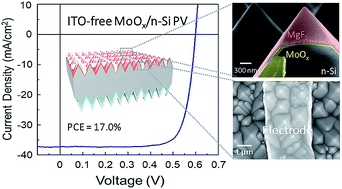
J. Mater. Chem. A, 2019,7, 2192-2199
https://doi.org/10.1039/C8TA11220G
Differences in bulk and microscale yttrium speciation in coal combustion fly ash
Yttrium speciation in coal fly ash differs depending on the scale of the analysis.
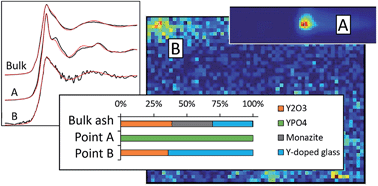
Environ. Sci.: Processes Impacts, 2018,20, 1390-1403
https://doi.org/10.1039/C8EM00264A
Repurposing bacterial extracellular matrix for selective and differential abstraction of rare earth elements
Highly robust engineered protein matrices derived from bacteria were used to isolate rare earth elements from mixtures of metals. The filters were re-used over multiple cycles and the bound REE were readily recovered.
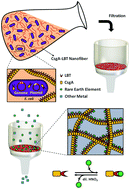
Green Chem., 2018,20, 3512-3520
https://doi.org/10.1039/C8GC01355A
Binder-free stainless steel@Mn3O4 nanoflower composite: a high-activity aqueous zinc-ion battery cathode with high-capacity and long-cycle-life
We report a binder-free stainless steel welded mesh@flower-like Mn3O4 composite with high zinc storage capability for aqueous zinc-ion batteries.
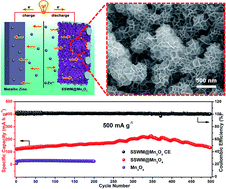
J. Mater. Chem. A, 2018,6, 9677-9683
https://doi.org/10.1039/C8TA01198B
About this collection
The world is scattered with unique materials with special functions that enable a whole world of consumer technology. However, supplies of these precious elements are limited and current recycling processes are inadequate. Manufacturers, retailers and investors can play their part by building sustainability into technology from production. Chemical scientists are key to solving the problems of electronics waste and scarcity of precious elements.
This cross-journal web collection highlights the latest research published in Royal Society of Chemistry journals from chemical scientists across the world to solve this global issue. The following journals are involved: Chemical Communications, Chemical Society Reviews, Dalton Transactions, Environmental Science: Processes & Impacts, Green Chemistry, Materials Advances, Polymer Chemistry, RSC Advances, Sustainable Energy & Fuels, Journal of Materials Chemistry A and Journal of Materials Chemistry C.
Research in this collection covers various aspects relating to reducing, reusing or recycling these key precious elements in electronics: tantalum, indium, yttrium, gallium, neodymium, praseodymium, dysprosium, lithium, cobalt, aluminium and nickel. Topics include mining and extraction techniques for these elements, sustainable electronics design, recovery and extraction of these elements from electronics and recycling processes and technologies.
To find out more about the Royal Society of Chemistry’s Precious Elements campaign and our wide diversity of resources on re-use, repair and recycle, please go to this link:
https://sustainability.rsc.org/
Royal Society Of Chemistry Books also of interest:
“Resource Impacts of Fully Renewable Energy Systems: The Case of Metals” by V. Moreau from “Life Cycle Assessment: A Metric for the Circular Economy”, edited by Aiduan Borrion, Mairi J Black, Onesmus Mwabonje
https://doi.org/10.1039/9781788016209-00337
“WEEE Waste Recovery” by Avtar S. Matharu from “Element Recovery and Sustainability” edited by Andrew Hunt
https://doi.org/10.1039/9781849737340-00207
“A Circular Economy for Consumer Electronics” by Marco A. Meloni from “Electronic Waste Management: Edition 2”, edited by G H Eduljee and R M Harrison
https://doi.org/10.1039/9781788018784-00066
Chemistry for Sustainable Technologies: A Foundation: Edition 2
Author: Neil Winterton
Print ISBN: 978-1-78801-205-8
ePub eISBN: 978-1-78801-933-0